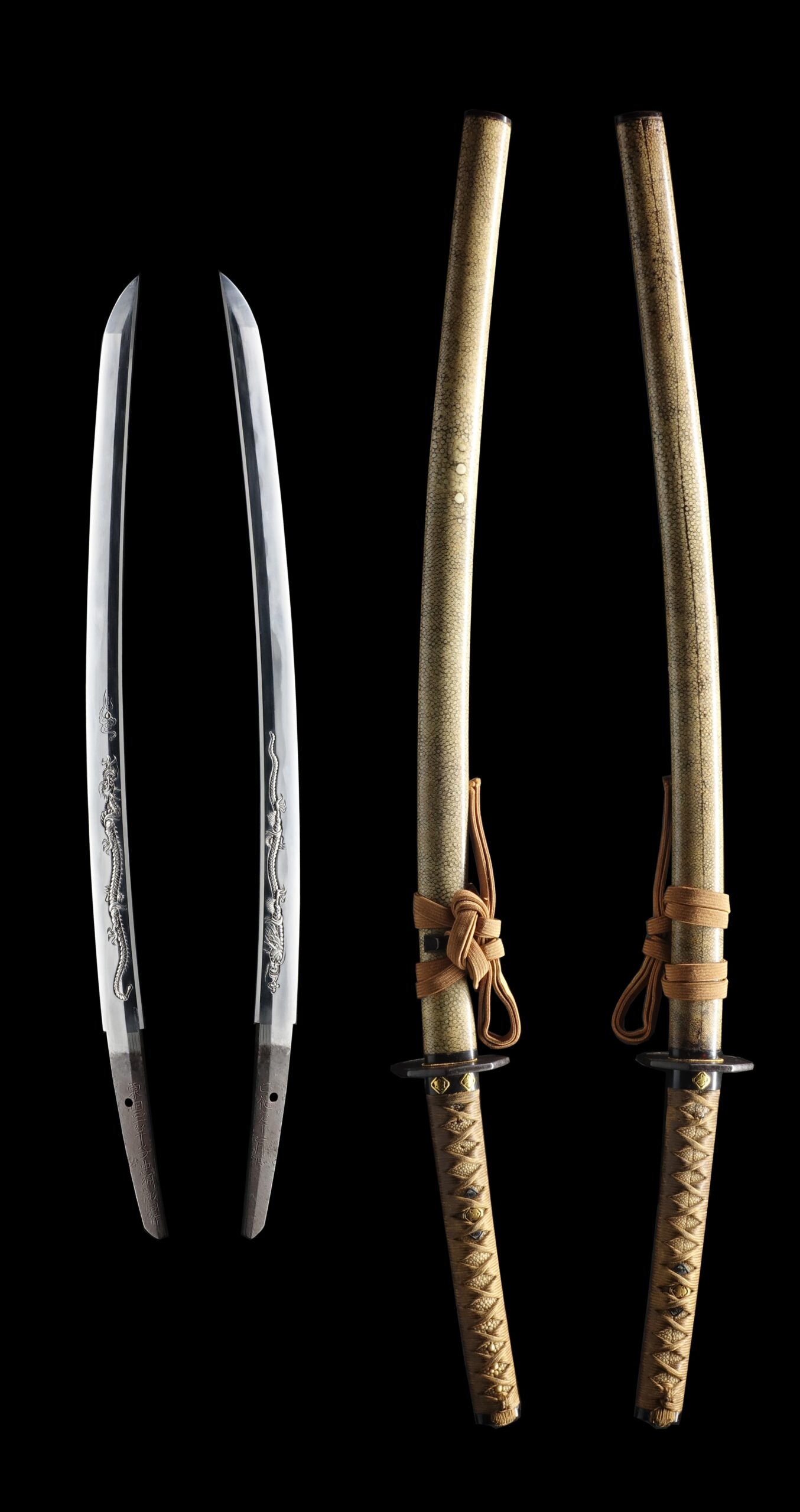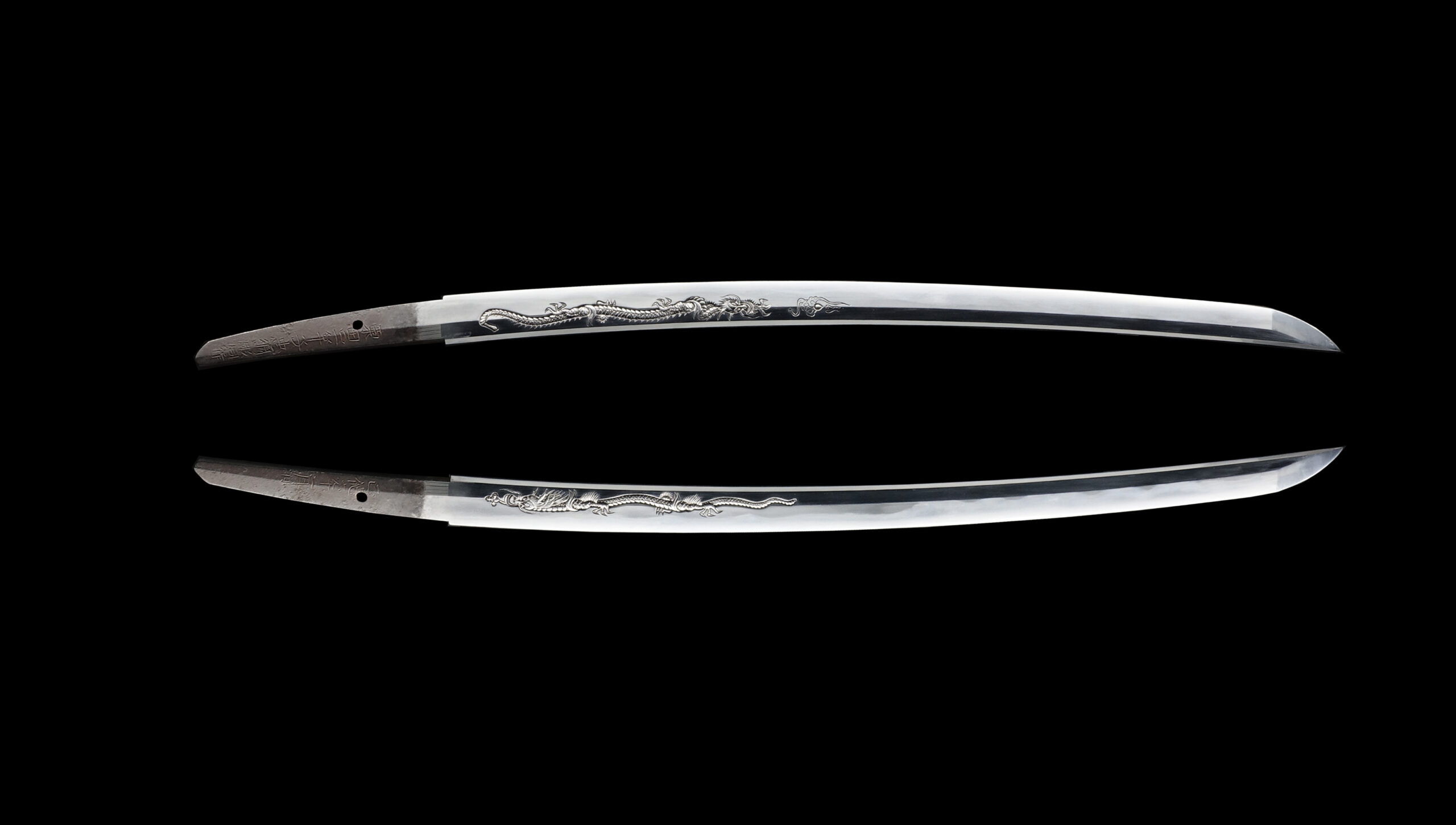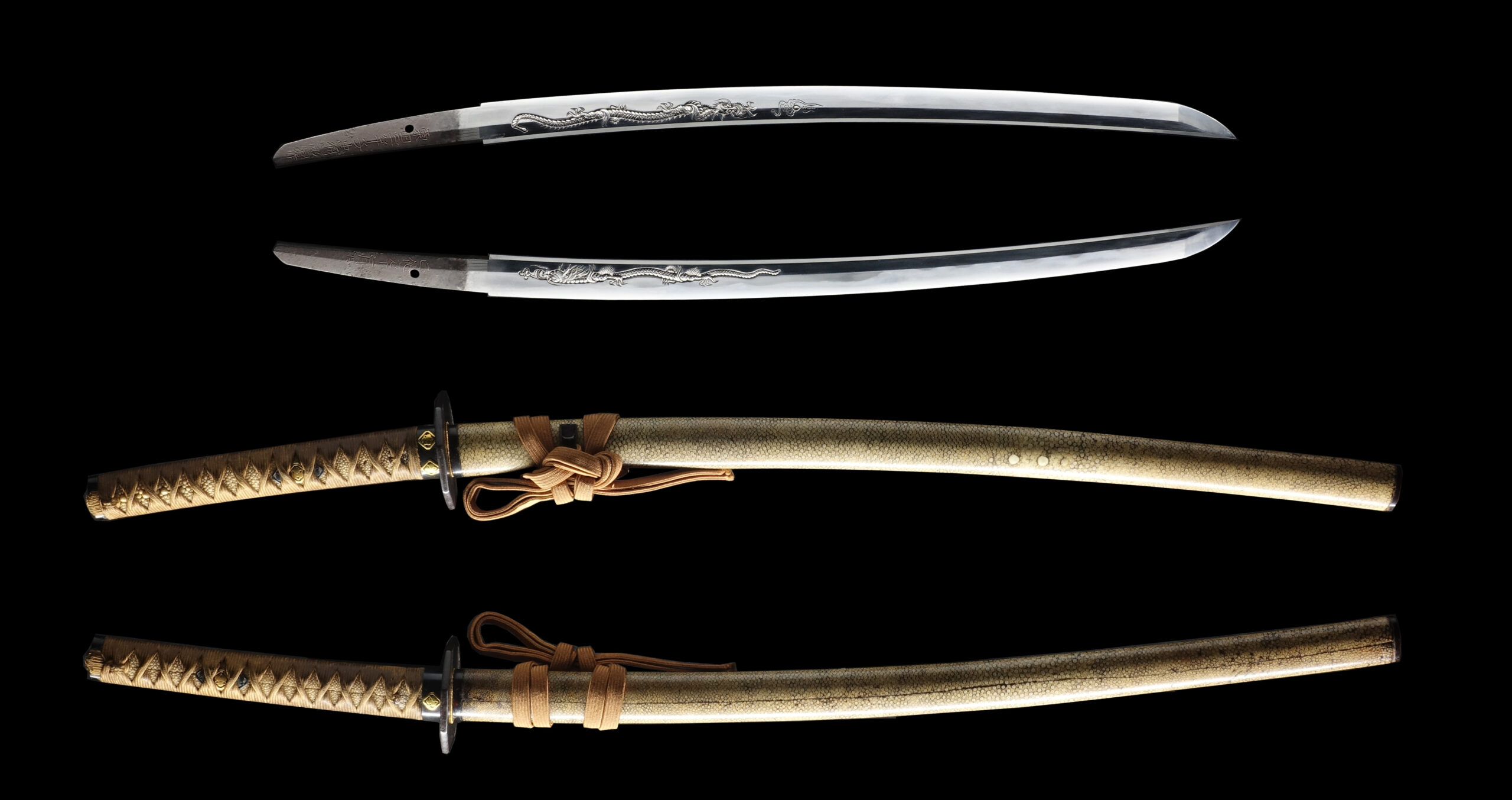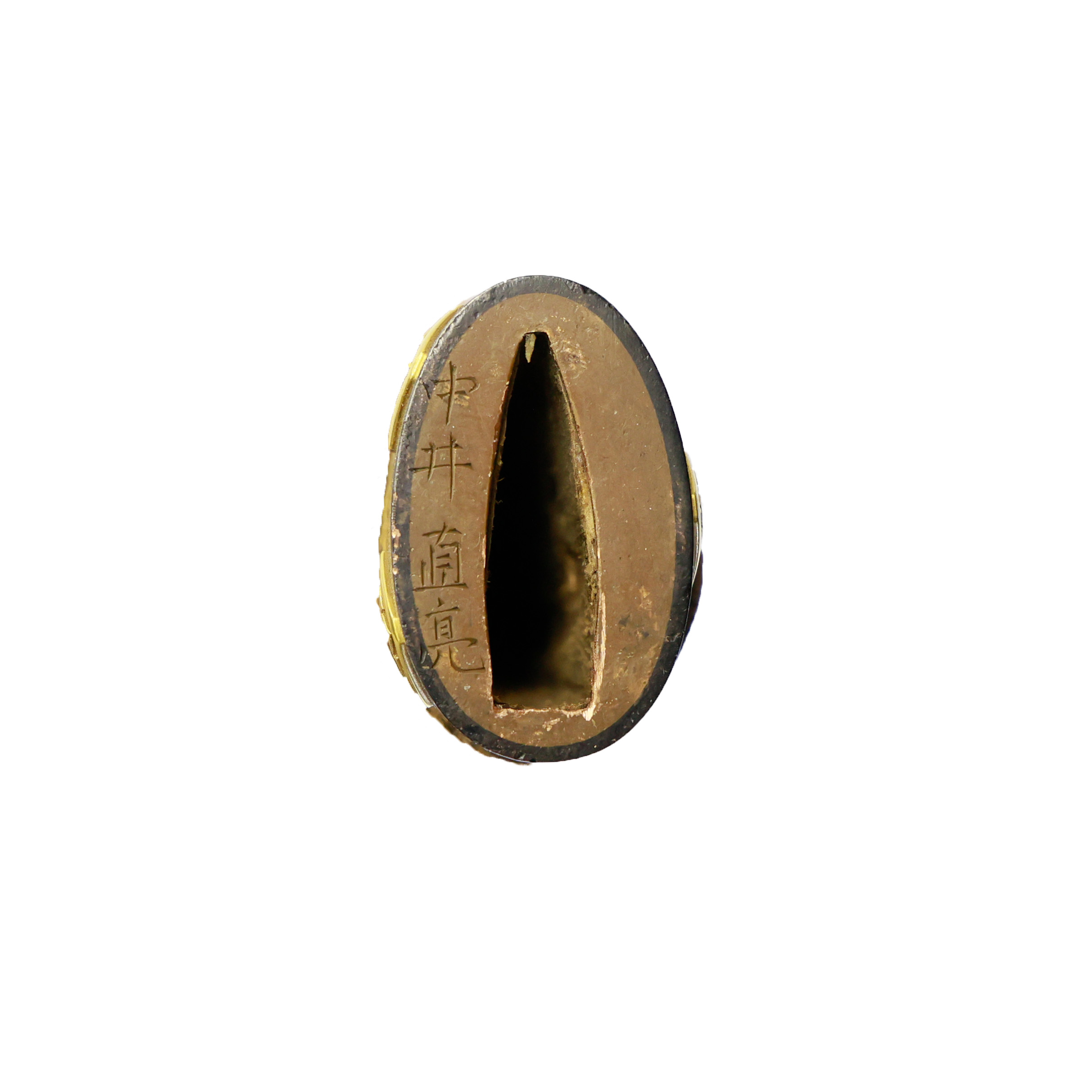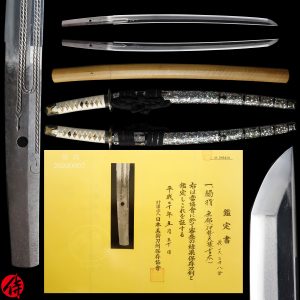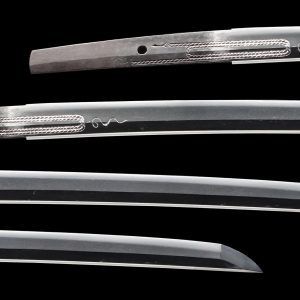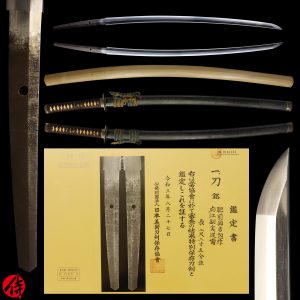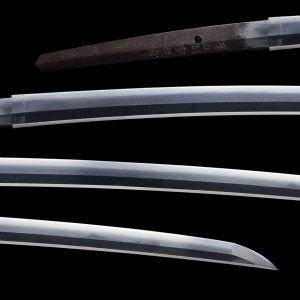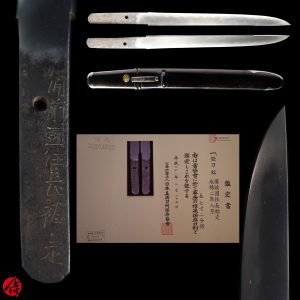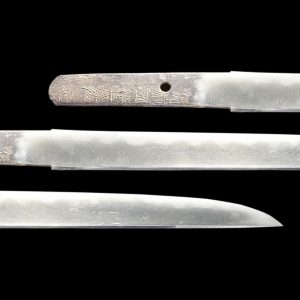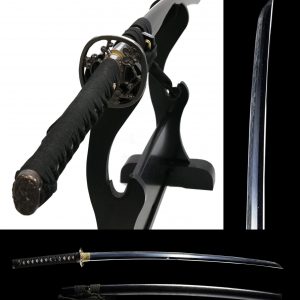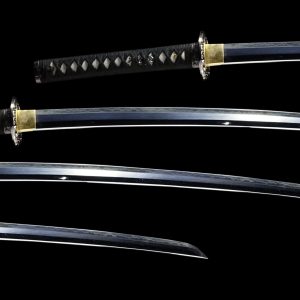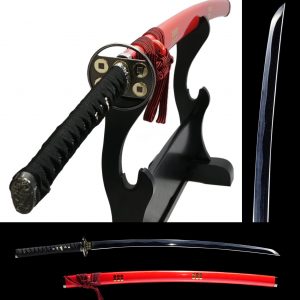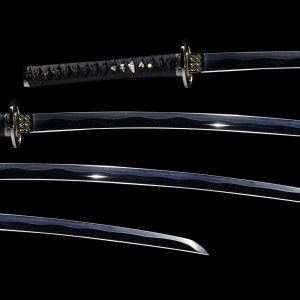Antique Japanese Sword Wakizashi Attributed to Tadakuni with NTHK Kanteisho Certificate
【Description】
This blade was signed by Awataguchi Ikkanshi Tadatsuna (粟田口一竿子忠綱) on February 1716 in Yamashiro province (today’s Kyoto). The maker’s name Tadatsuna lasted three generations, and this one was forged by the second-gen, based on the title “Ikkanshi”. The second-gen Tadatsuna was active in the early Edo period (Late 17th century), and he is one of Osaka’s most skilled and popular swordsmiths in the early Edo period, following Tsuda Sukehiro and Inoue Shinkai. These three sword makers are called Sanketsu of Osaka Shinto.
The second-gen Tadatsuna was born in 1644 as the first son of the first-gen Tadatsuna, who called himself the descendant of Awataguchi Kunitsuna, a famous swordsmith in the early Kamakura period. His father was born in Hyogo prefecture and forged swords in Ushiroyama castle in Mie prefecture. Eventually, the first-gen Tadatsuna moved to Osaka. The second-gen Tadatsuna’s real name is Asai Mandayu. The swordsmith’s name Tadatsuna lasted three generations, and the second-gen is said to have been the most famous and skilled one. And he was not only excellent at forging swords with different kinds of tempering lines (Hamon) but also excellent at inscribing sculptures on his work. This blade has beautiful dragon engraving and the signature says that it was made by himself.
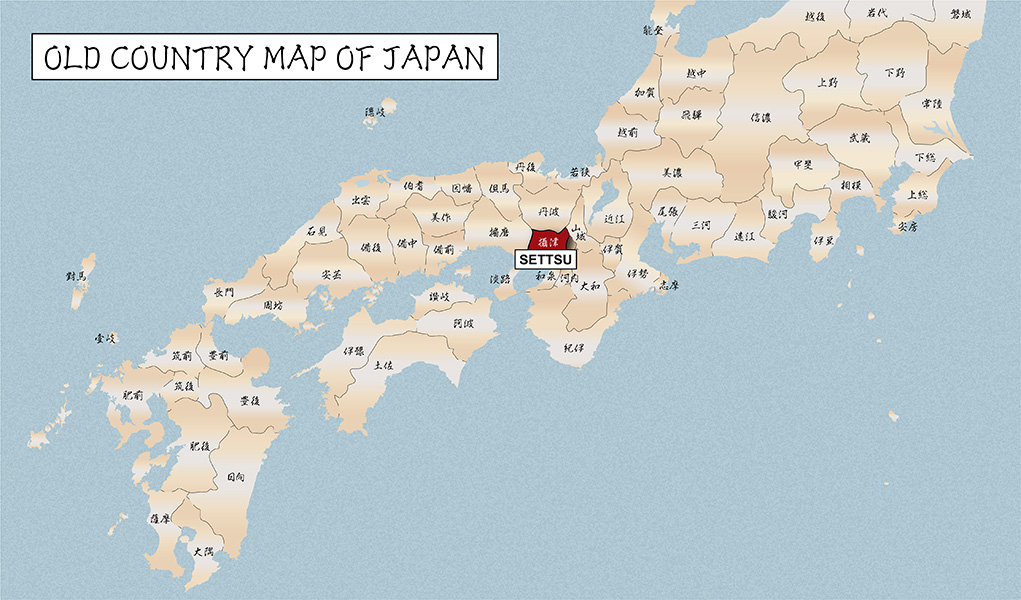
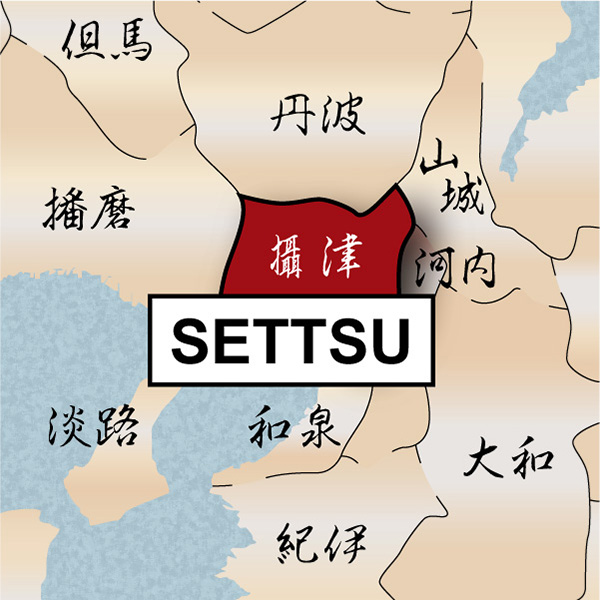
The second-gen Tadatsuna first signed as Tadakuni (忠国). According to his remaining work, he started to forge swords in 1672 and kept creating his blades until he was about 80 years old (1716). He received the honorable title of Omi no Kami during Enpo era (1673-1680). He started to sign Ikkanshi Tadatsuna after the second year of Genroku era (1689).
During the early Genroku era, he used 縄 letter instead of 綱 when signing his creation, but after the mid-Genroku era, he used 綱 to sign his blades. Since this blade was signed as 忠縄, we can assume it was forged around the late 17th century. Genraoku period lasted 1688-1704. He kept forging swords for about 50 years in his career.
One of Tadatsuna’s works is designated as Important Cultural Property of Japan. His swords are Ryuwazamono and Shinto Jyojyo Saku (Highly ranked swords among Japanese sword experts).
There is one interesting historical incident related to the work of the second-gen Tadatsuna. It was March 24th in the 4th year of Tenmei (1784). Sano Zenzaemon, A direct retainer of Shogun, attacked a son of Tanuma Okitsugu, who was the chief minister of the Edo government. Sano used a wakizashi signed by the second-gen Tadatsuna. The son was eventually died, and Sano was ordered to do Seppuku for his misconduct. Interestingly, since this incident happened, the price of rice decreased dramatically after the sharp rise, which suffered many people. And, people started to worship Tadatsuna’s swords as Yonaoshi Daimyojin, a Great God that makes the world a better place. The Tadatsuna’s popularity skyrocketed, and this incident is much talked about when you learn about the work of Tadatsuna. It is said that only noble high-class Samurai could afford to buy a sword forged by the Tadatsuna during the Edo period.
Osaka Shinto
The blades forged by Tadatsuna are categorized as Osaka Shinto. Shinto is Japanese Sword terminology that refers to the swords forged during 1596-1781. The blades made in the Osaka area during this period are called Osaka Shinto. There are many famous swordsmiths in this Osaka Shinto era. After Hideyoshi Toyotomi built Osaka castle, Osaka city flourished as a castle town and became the business center. Many swordsmiths moved to Osaka to look for better opportunities. They not only forged swords for those Samurai who lived in Osaka but also for feudal lords nationwide. Ikanshi Tadatsuna (Awataguchi Omi no Kami Tadatsuna), Inoue Shinkai, and Tsuda Sukehiro are the most famous among many swordsmiths.
One of the most notable characteristics of Osaka Shinto is its beauty in Jigane. Jigane is a visible steel surface pattern created by folding and hammering during the forging process), which made it possible by the location of Osaka. Osaka had close access to the Tamahagane (special carbon steel to make Japanese swords) production sites. The swordsmiths residing in Osaka were able to get high-quality carbon steel from these sites.
Horimono (Engraving)
This blade features exquisite engravings (Horimono, 彫り物) on both sides of the blade.
The dragon carved on the front, rising while holding a jewel, represents the dragon ascending towards the heavens with the jewel. This jewel is often depicted as a “precious jewel” or “pearl,” symbolizing wisdom or power. The rising dragon suggests physical or spiritual growth and the idea that the sword’s owner should strive for high ideals and strength.
On the other hand, the dragon carved on the back, descending, is often seen as a symbol of bringing power down to the earth. The descending dragon implies the return of the gained strength to the world, or serving as a protector.
In this way, the rising and descending dragons reflect the flow of power and the process of spiritual growth, as well as the balance between ideal pursuit and real-world stability.

*Please keep in mind that there is a tiny black rust on this blade. If you like to know the detailed condition, please feel free to contact us.
【 Blade】
Cutting Edge Length(Nagasa): 51.5 cm ( 20.3 inches)
Curvature(Sori):1.51 cm (0.59 inches)

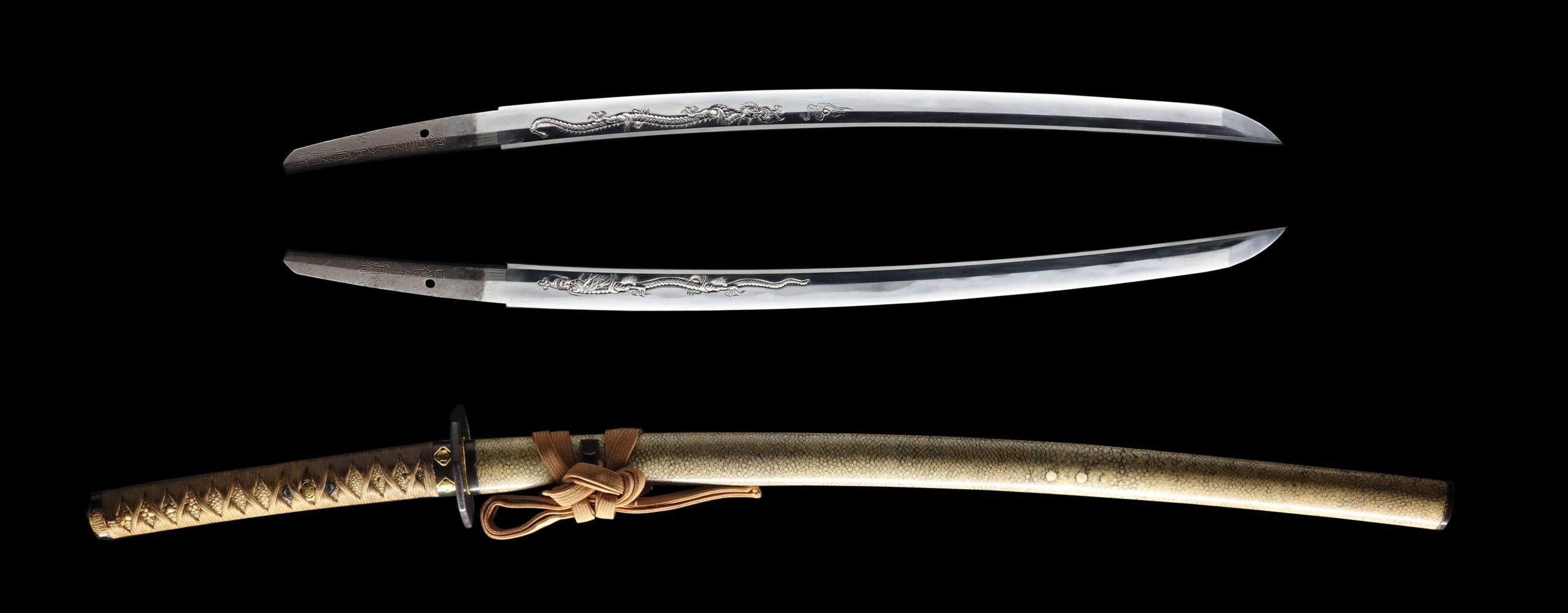
Hamon:
The crystalline structure which forms along the cutting edge of a blade as a result of the hardening process
Jimon(Jihada):
visible steel surface pattern created by folding and hammering during forging process


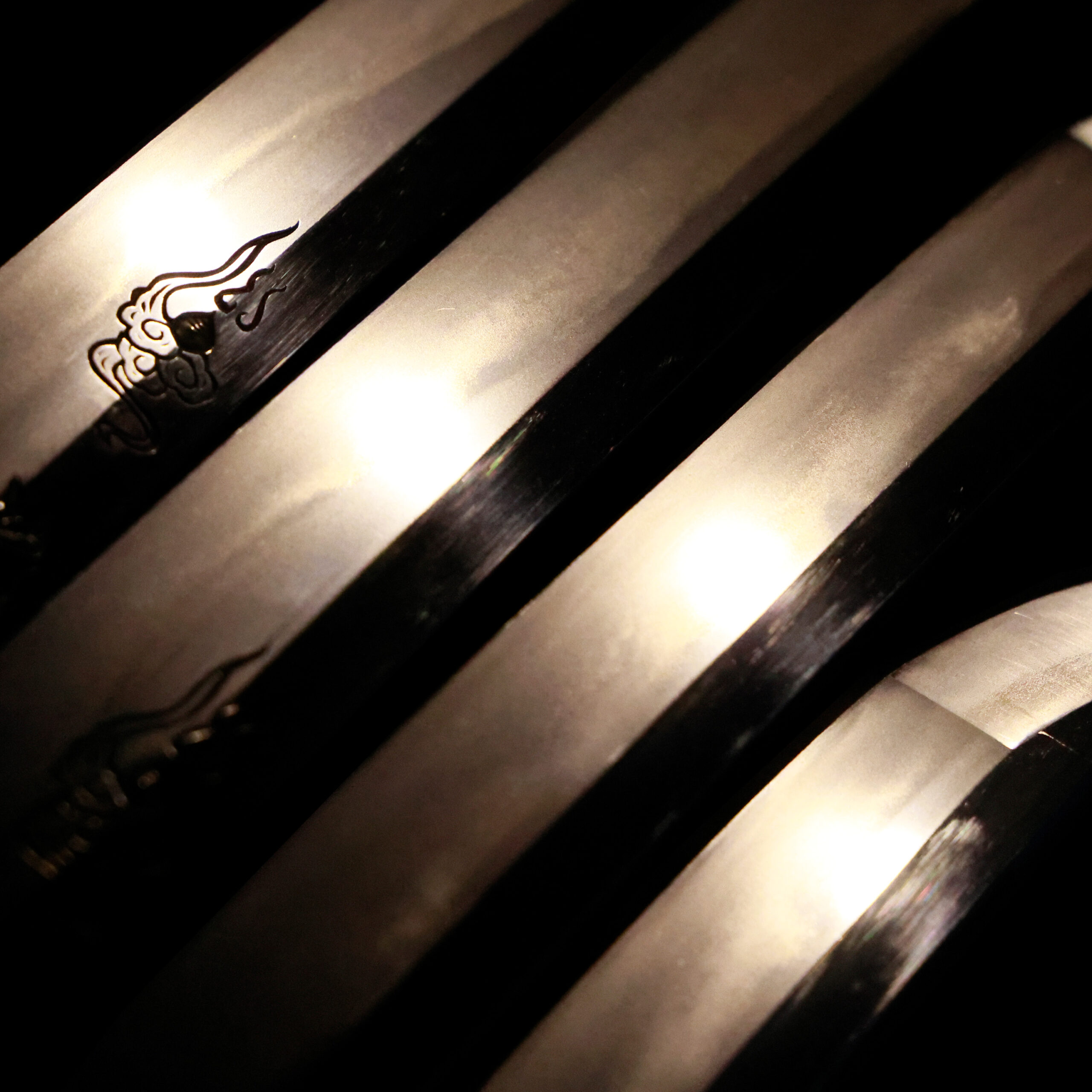
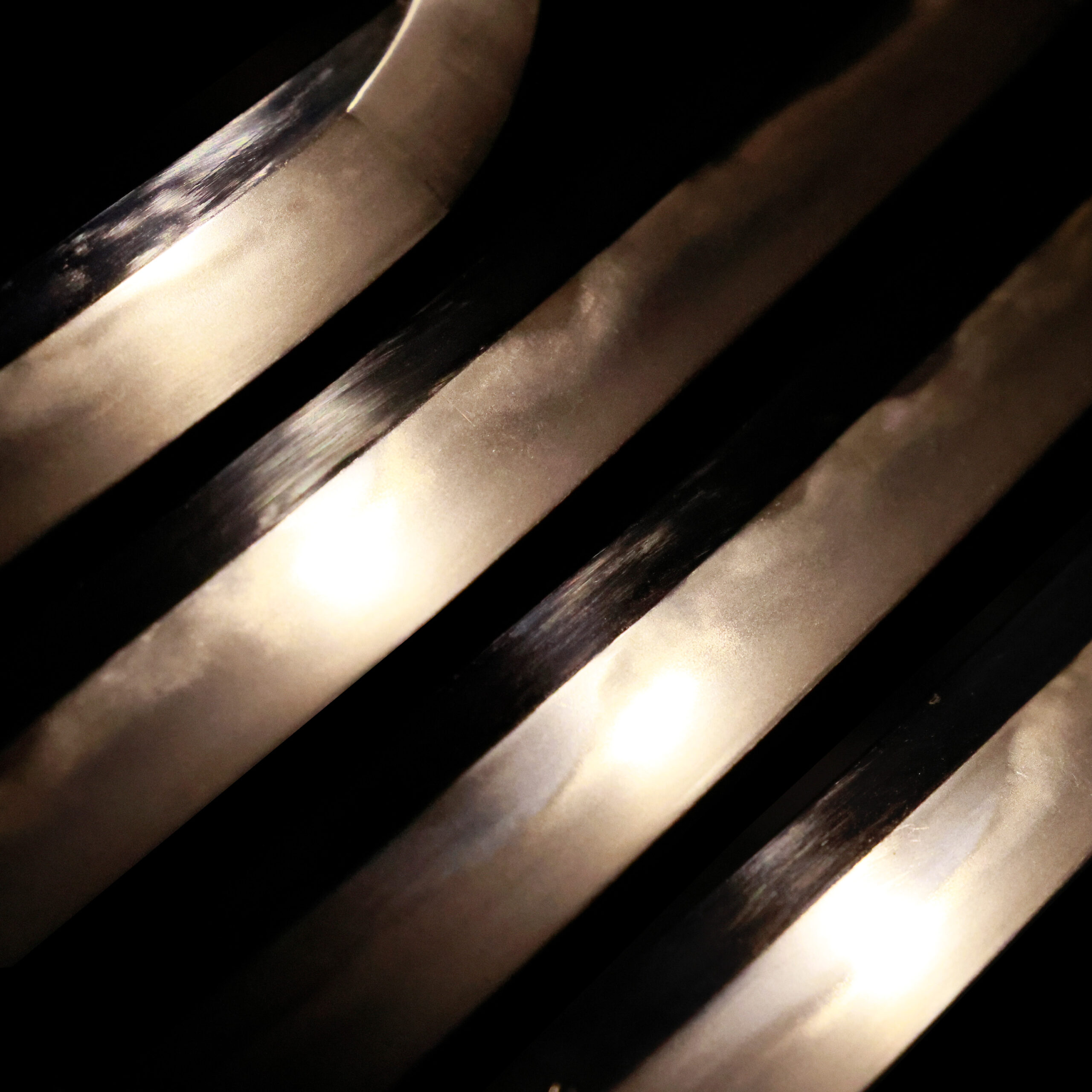
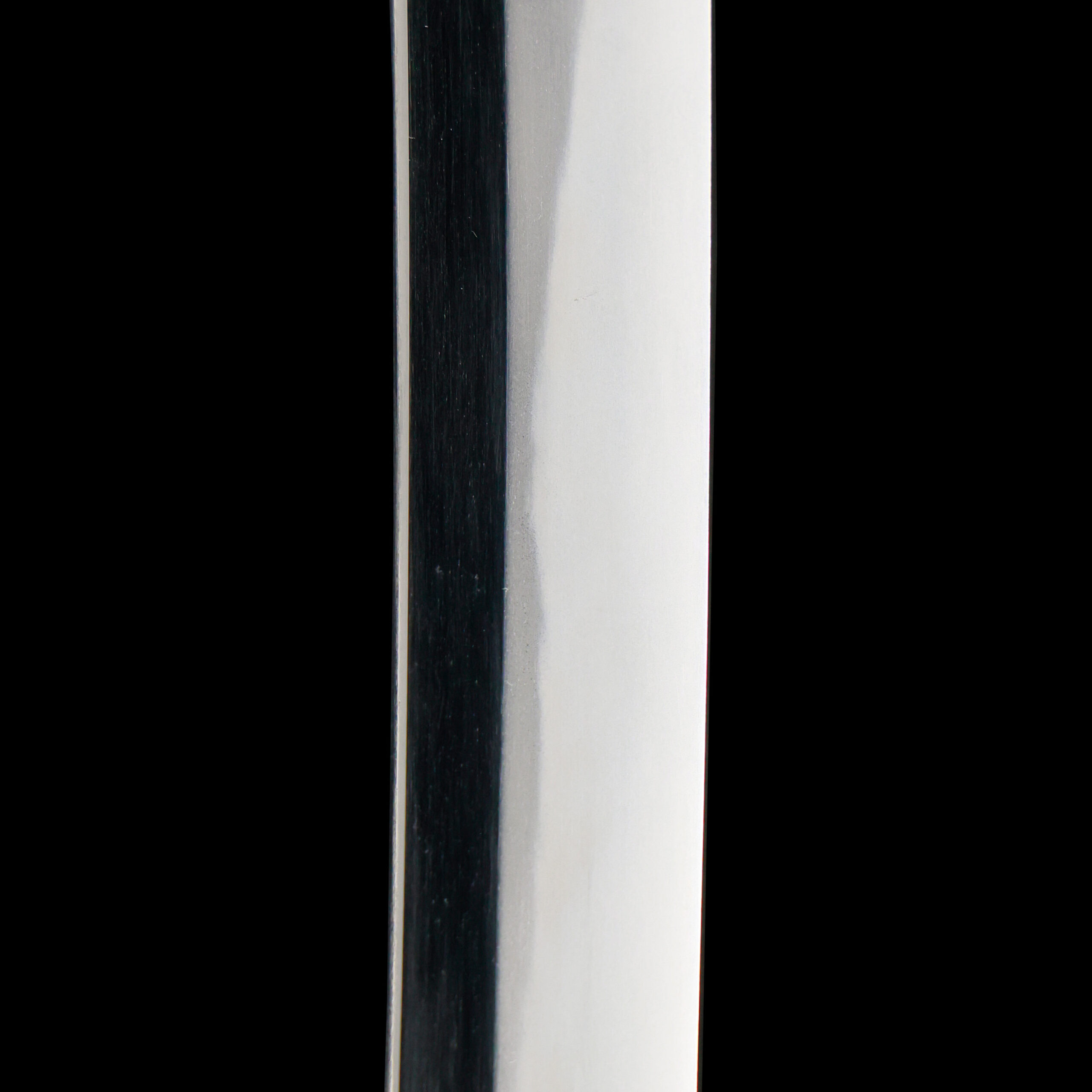

Kissaki: Kissaki is the tip of the Japanese sword.

Nakago:Nakago is the tang of the Japanese sword.
Japanese swordsmiths left the black rust on the tang because it prevents red rust while the tang is in its handle. And the discoloration of the tang was created over time, and it is a great indicator for a Japanese sword specialist to estimate when the sword was forged.

Koshirae:Koshirae is the mounting of the Japanese sword. There are several parts that consist of Koshirae such as Saya (Scabbard), Tsuka (Handle), Tsuba (Handguard).
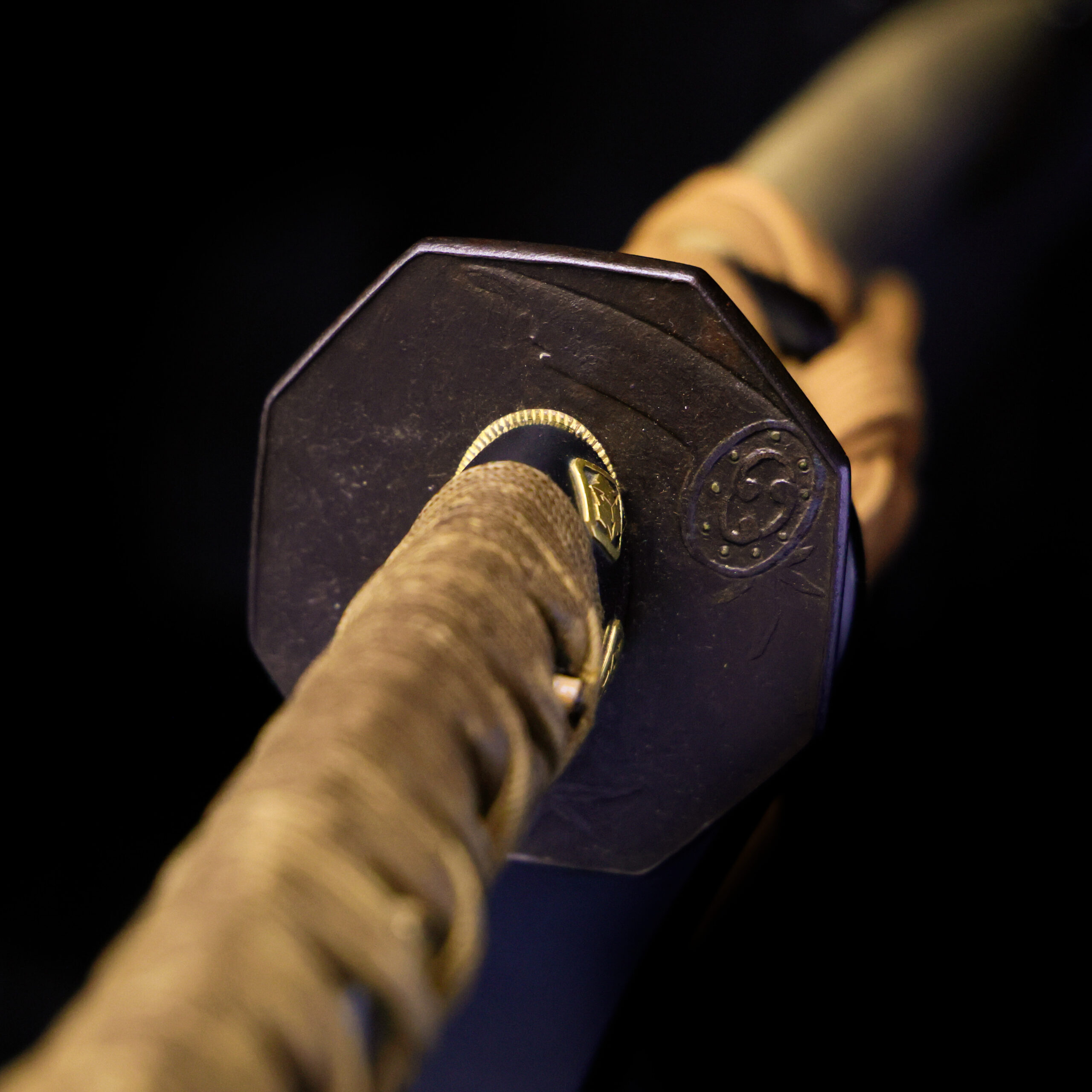
Fuchi-Kashira:A pair of matching sword fittings that cover the upper and bottom parts of its sword hilt.
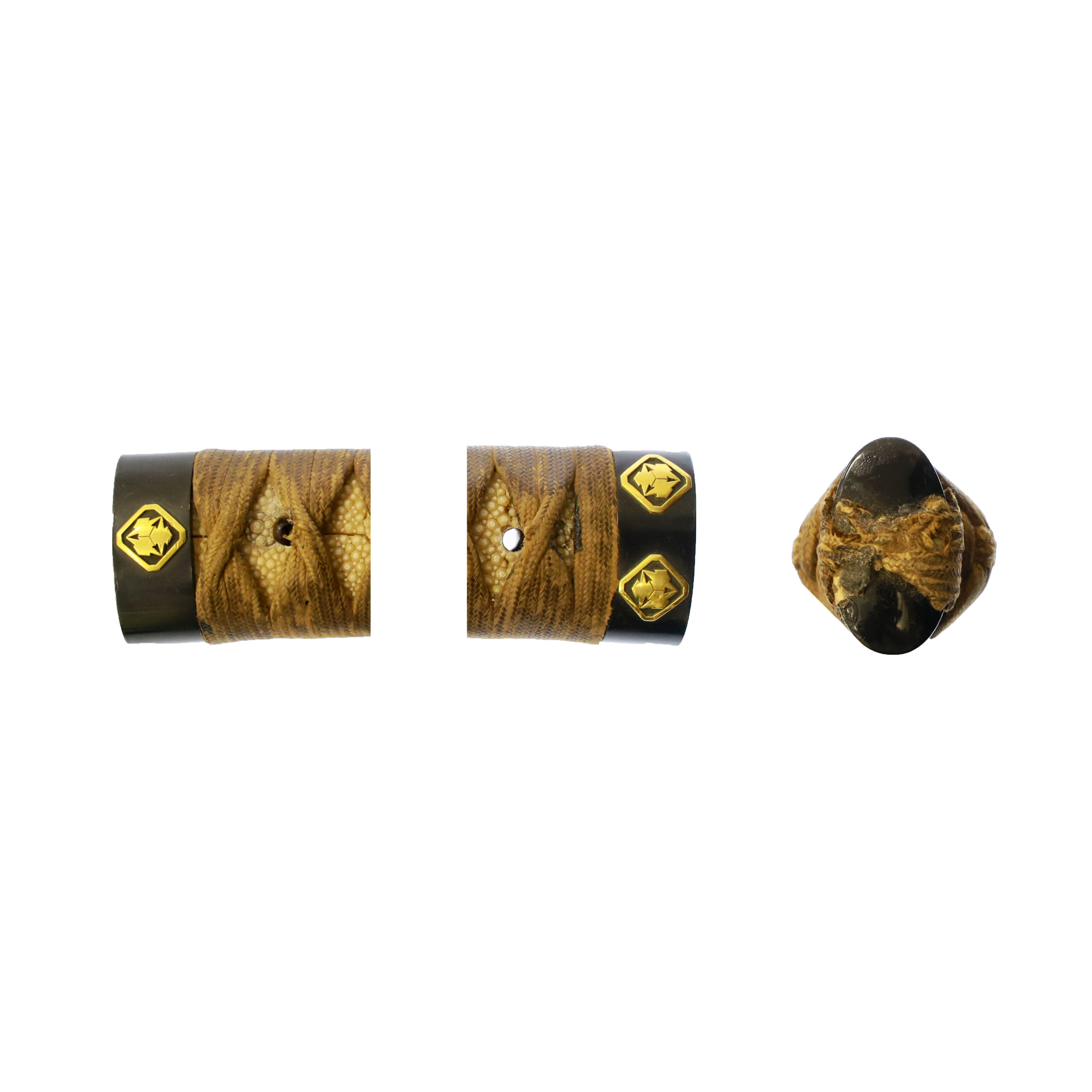
Tsuka and Menuki:Tsuka is the handle of the Japanese sword and Menuki is its decoration.
The motif of this menuki is the “Mitsumatsu Kawabishi” family crest. This crest features a design with three “Matsukawa-bishi” symbols. A famous samurai family that used this crest was the Takeda clan. The Matsukawabishi design is a geometric pattern inspired by the bark of a pine tree. The design resembles a diamond with small diamonds added above and below it. The pine tree has been regarded as an auspicious symbol of longevity as hermits with divine powers lived in pine tree-made houses and ate pine trees. It is said that the pine bark rhombus was used in family crests to protect against evil spirits.
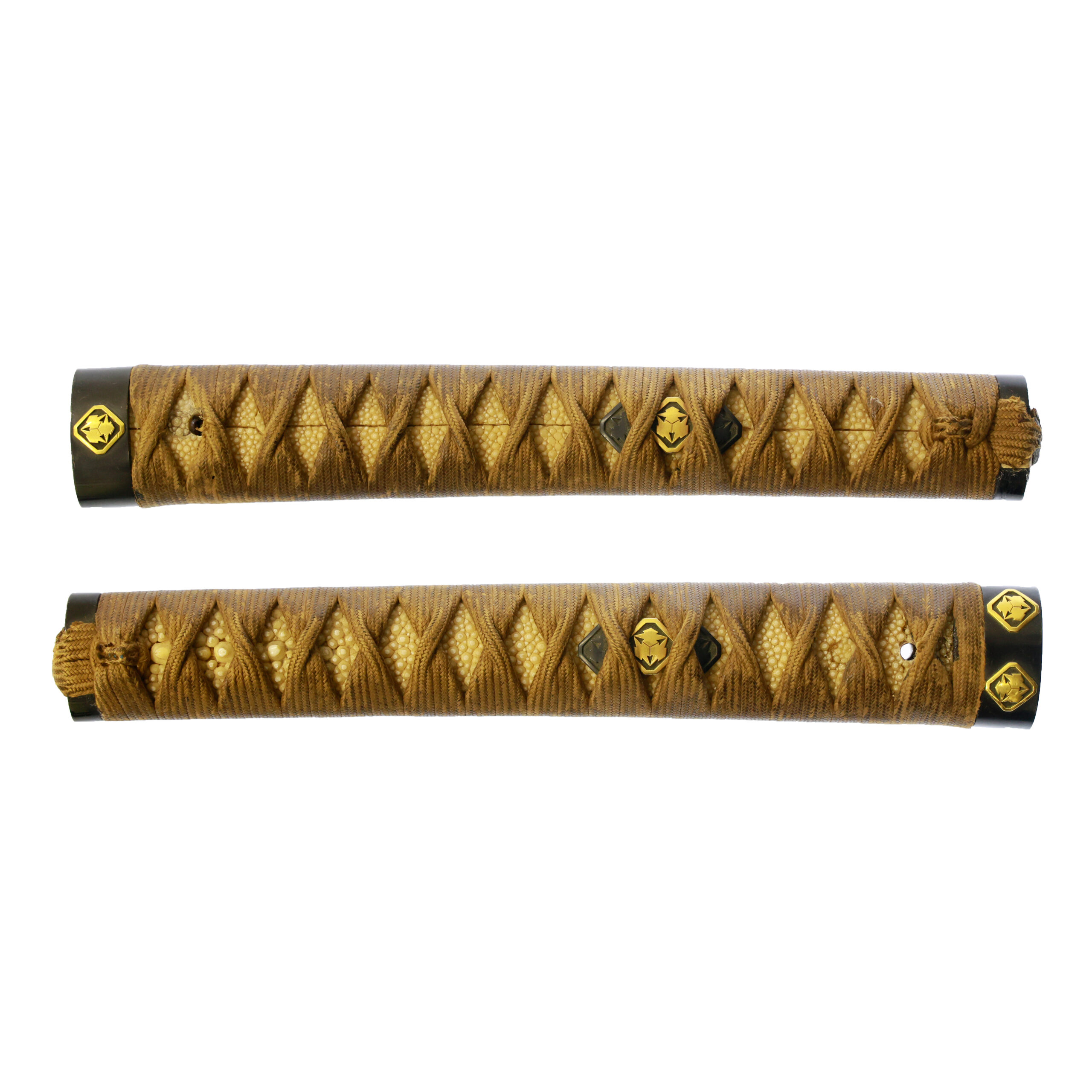
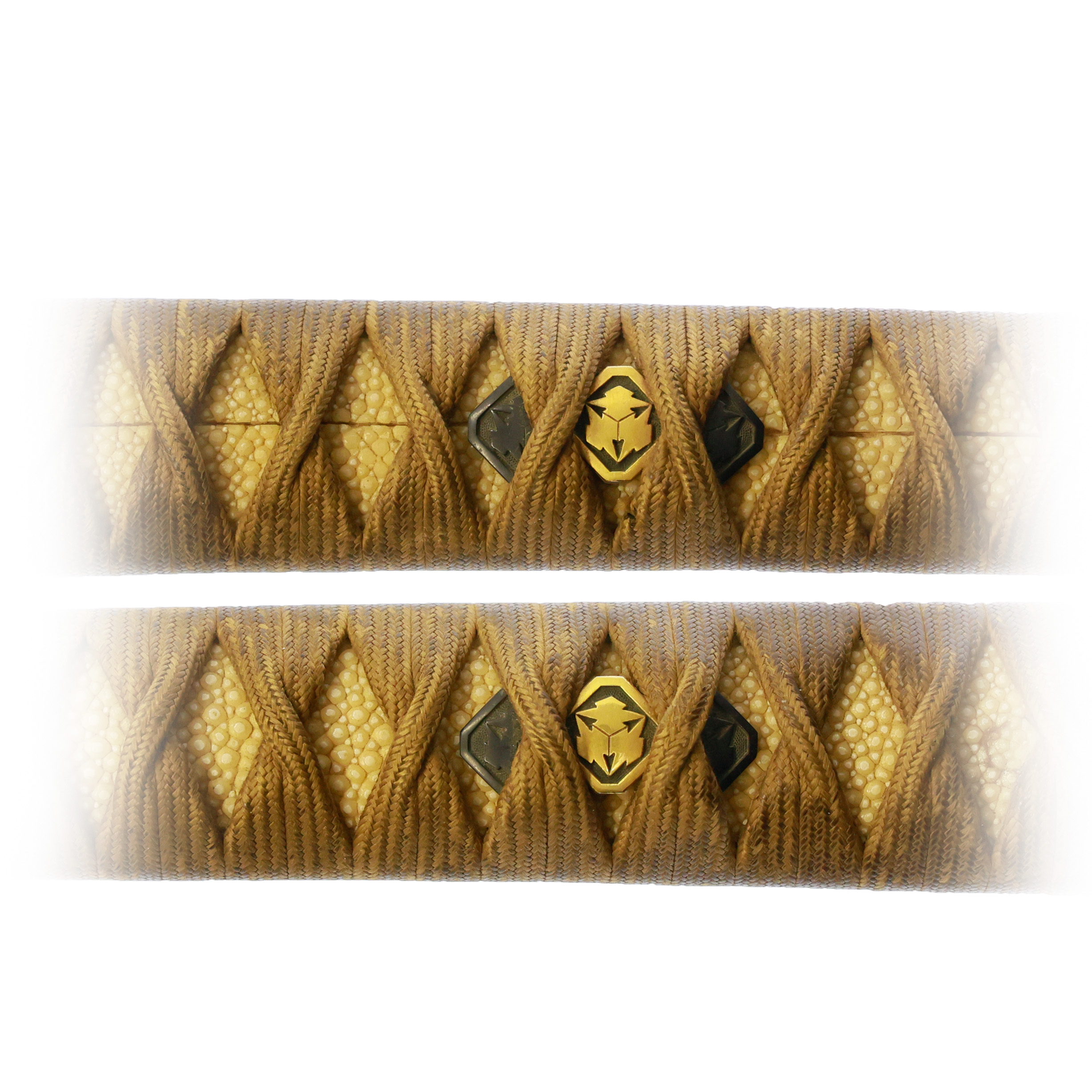
Tsuba and Habaki:Tsuba is the handguard for the Japanese Sword and Habaki is the equipment to make the blade not touch its scabbard inside. It prevents the blade from getting rusty and chipped.
The theme of the Habaki is wave. As waves’ movements continue endlessly, the wave pattern represents eternity, immortality, longevity, birth, etcetera. Also, since tides repeatedly change the shape and terrain of rocks, some people hoped for a strong will by using this motif. People used this pattern wishing for an indomitable spirit to rechallenge time and time without giving up. Thanks to its dynamic design, this motif has been appreciated, especially for men’s Kimono (traditional Japanese costume).
There is a geometric design of wave pattern; the Seigaiha Monyou (青海波文様). According to a theory, this design symbolizes the benefits of the vast sea. This infinite wave pattern is an auspicious pattern. People used it, wishing eternal happiness and peaceful lives for the future.
The motif of the Tsuba is maple. According to a theory, this plant motif represents longevity. Maple leaves change their colors from green to yellow, orange, or red. The fall foliage is one of the charms of autumn. Due to this behavior of the color, this design represents someone who knows how to get along in the world and be happy. The pattern that depicts maple leaves run into the water is called Ryusui Momiji Mon (流水紅葉文).
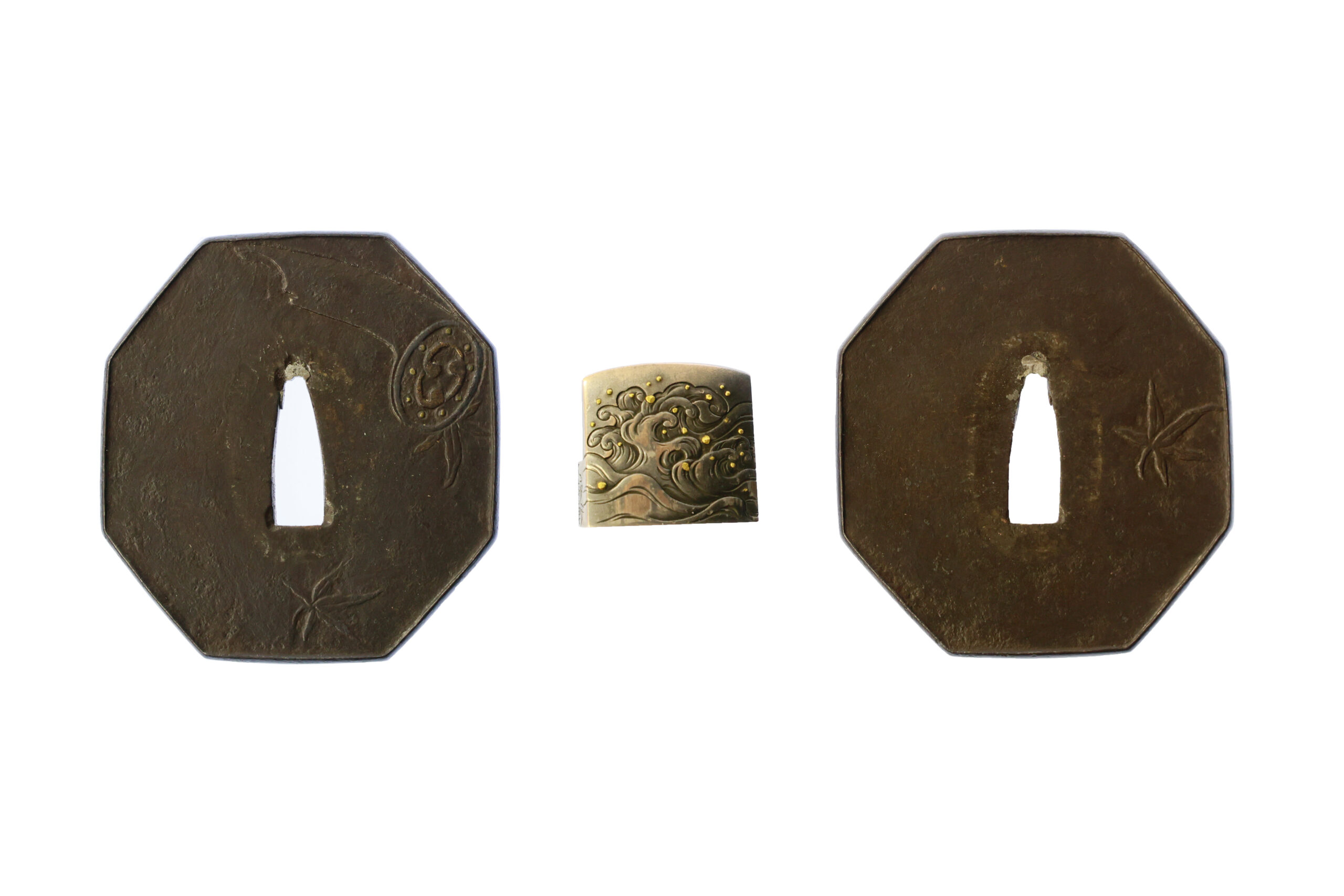
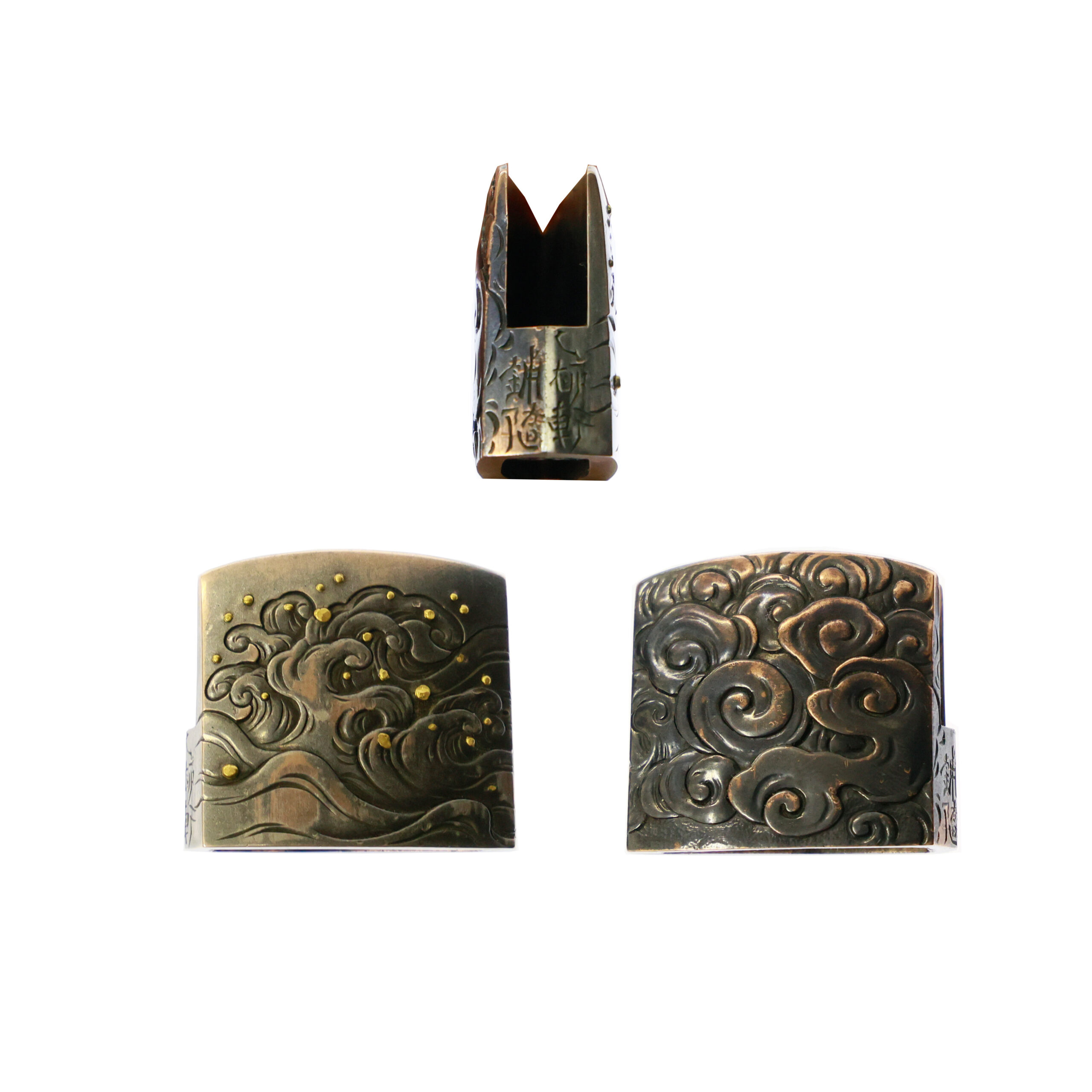
Saya:Saya is the scabbard for the Japanese sword.

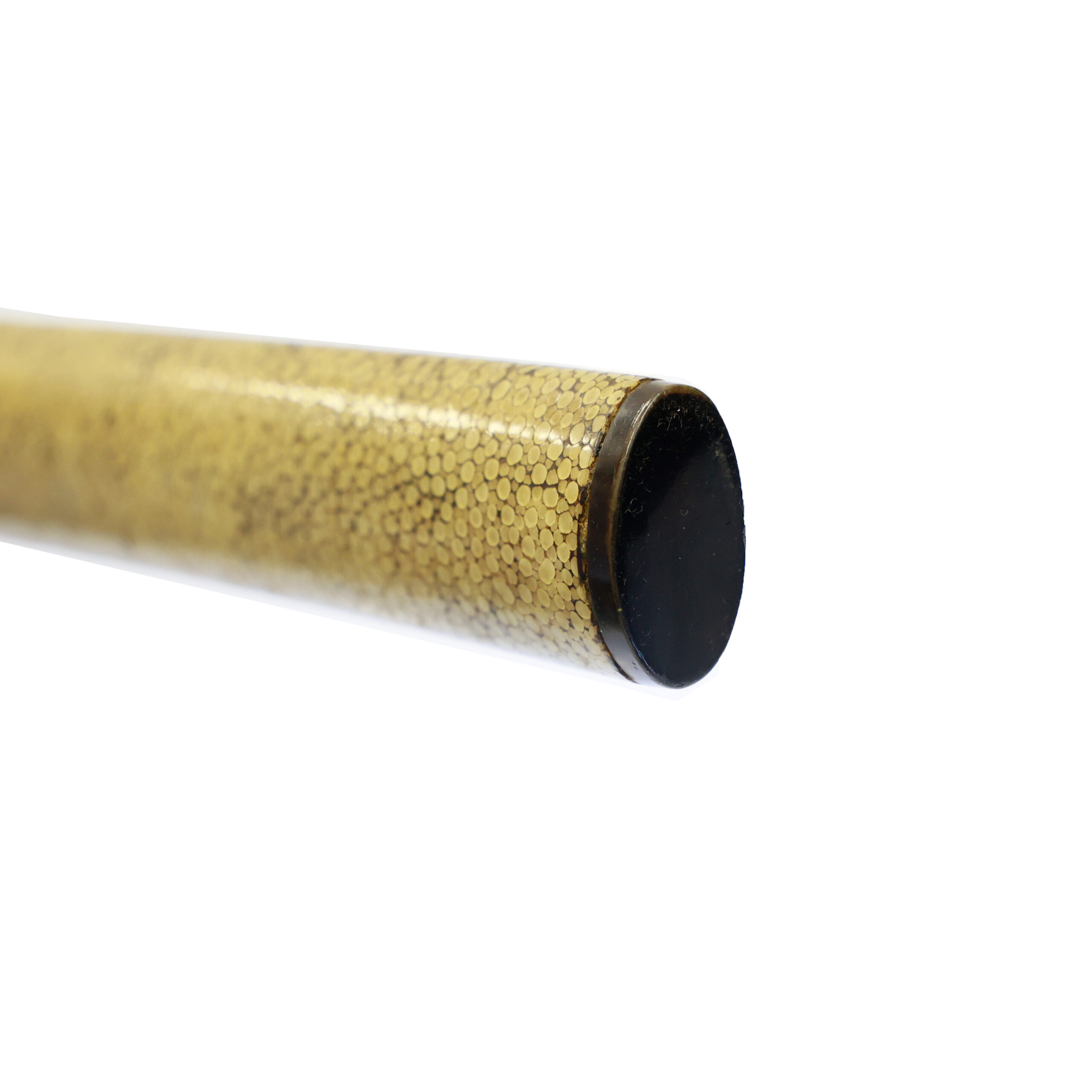
Authentication Paper:NTHK Kanteisho Certificate for the blade
NTHK, also known as NPO Nihon Touken Hozon Kai, is the oldest organization for sword authentication of Japanese swords in modern times. It was established in 1889 during the post-Samurai era. They authenticated the blade on November 17th in the 6th year of Reiwa (2024). The purchaser will receive this original certificate as well. We can also translate what is written into English and make a PDF file for your record if you request.
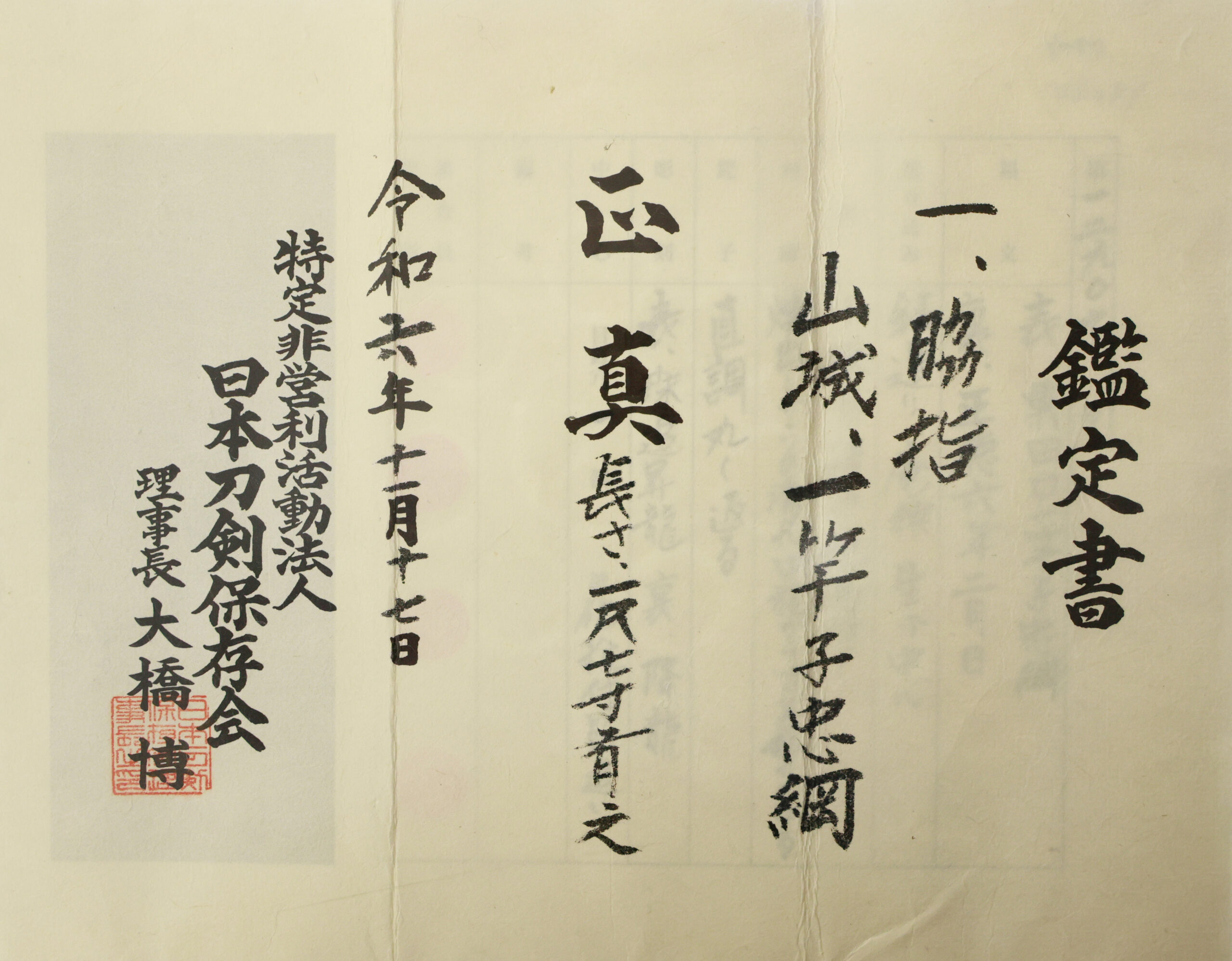
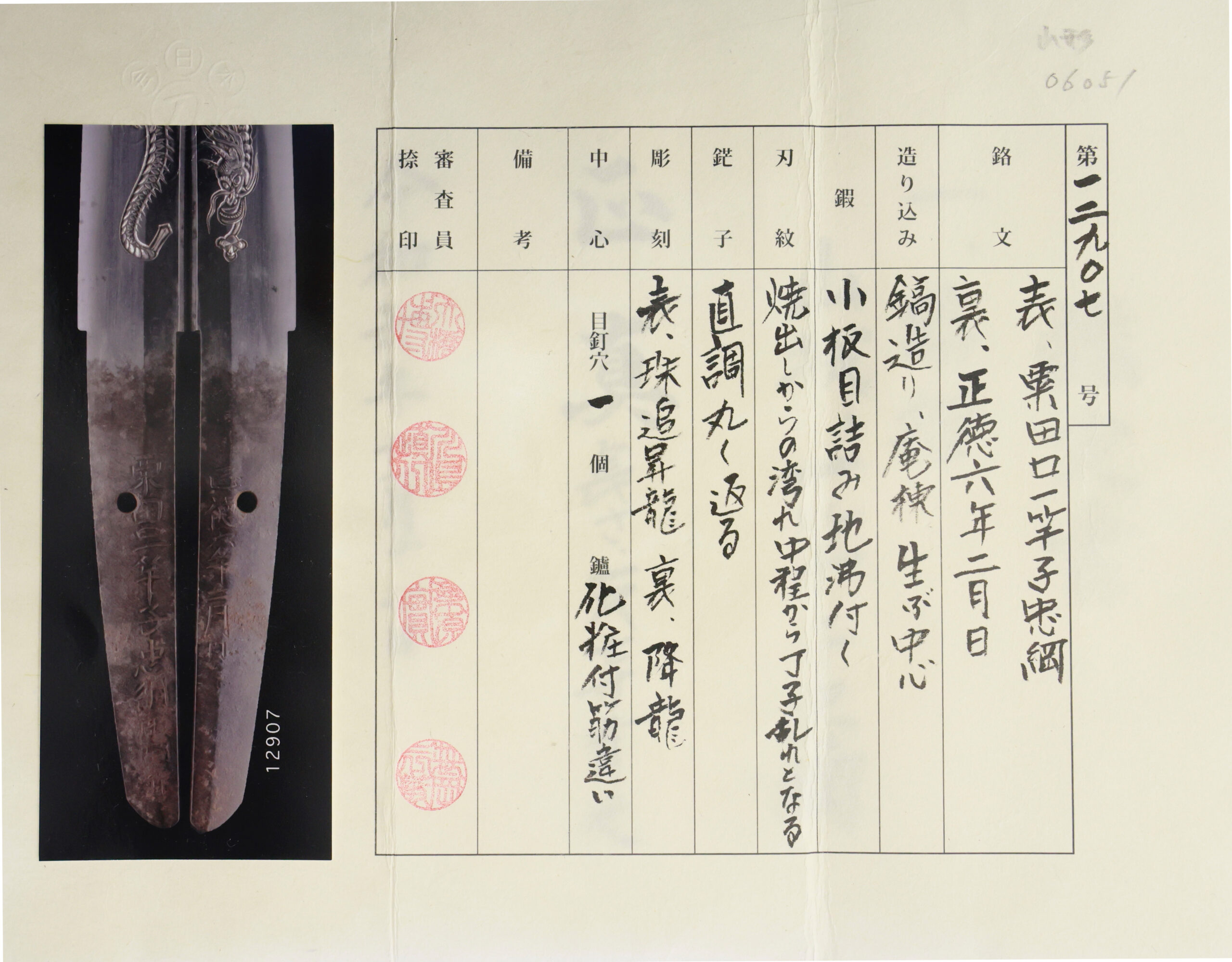
Registration Number : Yamagata 06051
The Board of Education in Yamagata prefecture issued a registration paper for this sword . It is called Jyu Token Rui Torokusho(銃刀剣類登録証). Bunkacho(The Agency for Cultural Affairs) acknowledges a Japanese sword with this paper as a work of art.
The sword needs to be traditionally hand-forged and made of Tamahagane carbon steel to be registered in the system. With this paper, its owner in Japan can legally own an authentic Japanese sword. Based on this registration number, we will apply for its export permit.
This paper will need to be returned to the board of education when the sword is being shipped abroad, but you can receive a copy of it. An English translation of this registration paper is available on request.
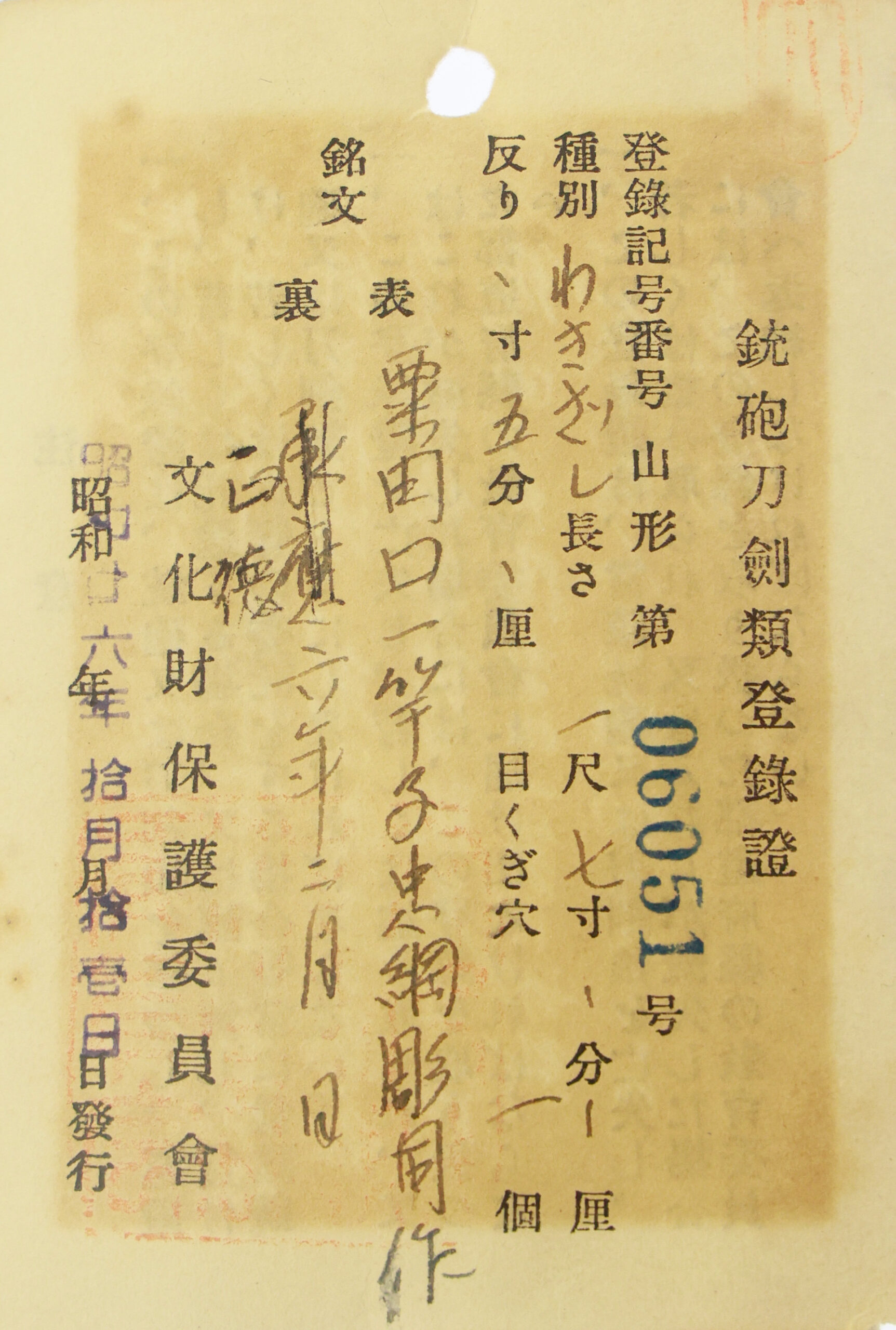

—————————————————————–
【About us】
Samurai Museum is located in Tokyo, Japan, exhibiting antique artifacts related to the Samurai history. Samurai Museum Shop is the place for those who are interested in Japanese culture and craftsmanship. We deal with antique Samurai swords/armor, traditional crafts made in Japan and so on.
【Japanese Sword& Export Process】
The Japanese swords we deal with are hand-forged edged swords made in Japan. It was made from the traditional carbon steel called TAMAHAGANE(玉鋼). Samurai Museum is familiar with the proper legal procedure for an antique/ authentic Japanese sword to be exported from Japan. We have sent more than 700 Japanese swords for the past few years (~2024) to amazing owners who appreciate its historical value.
Each Japanese sword is registered under the Agency for Cultural Affairs and the Board of Education in Japan. They issue a registration paper for each Japanese sword for its owner in Japan to legally possess it. The Japanese sword with its registration paper means it was traditionally hand-forged in Japan.
To legally export the sword from Japan to other countries, we will have to apply for its permit to the Agency for Cultural Affairs(Bunkacho) and return the original registration paper to the Board of Education. It normally takes around 2-4 weeks to receive this permit after submitting required documents. And we would like you to expect at least 1-1.5 months for your order to arrive at your given address after you ordered. For more detailed info, please click here.
It is allowed for residents in Japan to own authentic Japanese swords without a special license as long as they come with registration papers. Please feel free to contact us if you are a resident of Japan, whether temporarily or permanently. We will also assist you when you leave Japan and need to obtain the export permit.
【Payment Method】
We accept payment through Stripe (Credit card), PayPal, Apple Pay or ChromePay, all of which are secure payment methods. Also, you don’t need to make an account on Stripe for the checkout. If you prefer other payment method, please contact us. After confirming your payment, we will apply for an export permit. You may either pay in JPY, USD, AUD, CAD,EUR CHF or GBP. The price is set in Japanese Yen. Prices in other currencies are automatically calculated based on the latest exchange rate.

* If the amount is above 1 million JPY, Stripe or wire transfer will be the only options for payment.
【Shipping】
We have shipped authentic Japanese swords to the USA, Canada, Mexico, Germany , Belgium, France, Finland, Hong Kong, Australia. If you don’t live in these countries and like to order, please contact us first before making a purchase. We offer Free International Shipping as long as we can send antique Japanese swords by EMS.
We normally ship by EMS(Express Mail Service) provided by Japan Post. We will send you a tracking number for your order as soon as we hand it to the post office. We will put 100 % insurance on the shipping document without any extra charge. Based on the total amount, there might be a duty tax or other fee for you to pay, depending on the countries. We use package cushioning to protect the item and put it in a PVC pipe, which is one of the most secure packages because of its durability.
It will normally takes 5-14 days for the item to arrive at your given address after we dispatch it. Time of delivery is estimated as accurately as possible by the carrier but does not take into account any delays beyond our control such as by inclement weather, post office holiday seasons.
* If you live in Australia and like to purchase an authentic Japanese sword, please click here to know the detail.
* If you live in the UK and like to purchase an authentic Japanese sword, please contact us first and click here to know the detail.

【Review】
Here is one of the reviews we received from a customer who purchased an authentic Japanese sword from us. For more reviews, please click here.
“My experience overall with the whole process was wonderful. I had many questions about the history and process to purchase these treasures. All my questions were answered very timely and complete. The staff is very knowledgeable and very well versed if any questions do arise.”
【How to make sure the condition】
Please keep in mind that what you are going to purchase is an antique item. We uploaded high resolution photos for you to check its condition thoroughly. If you like to see more photos with different angles, please feel free to contact us. We will be happy to send them to you so that you can make informed decision. It is essential for us to know that you are happy with your choice of a sword. and we are prepared to use the best of our ability to serve you.
【How To Contact Us】
Please contact us through email, Facebook Messenger or Live Chat if you have any questions. You can find each icon on the right side of the website. Please click one of them to reach us. We will reply to you within 1-2 business days.
【The Art of Nihonto (Japanese Sword)】
Samurai’s history is a profound, eloquent legacy of ancient Japanese warriors in which millions of people worldwide are being fascinated. If you like to find out the art of Nihonto, please click here.
【A Guide to Japanese Sword Maintenance】
After acquiring an genuine Japanese sword, it is also important to know how to take good care of it. Here is the special video for you. Mr. Paul Martin, Japanese sword expert, shows you how to give proper maintenance to your sword. By mastering how to clean the Japanese sword, its aesthetic beauty will last forever.
When you purchase a Japanese sword from us, you can get a Free Japanese sword maintenance kit. It comes with four tools(Choji Oil, Uchiko Whetstone Powder, Peg remover, Oil Applicator). By watching the video instruction above , you can enjoy learning how to maintain your Japanese sword while appreciating it. If you have any difficulty assembling the sword or cleaning the blade, you can feel free to contact us.
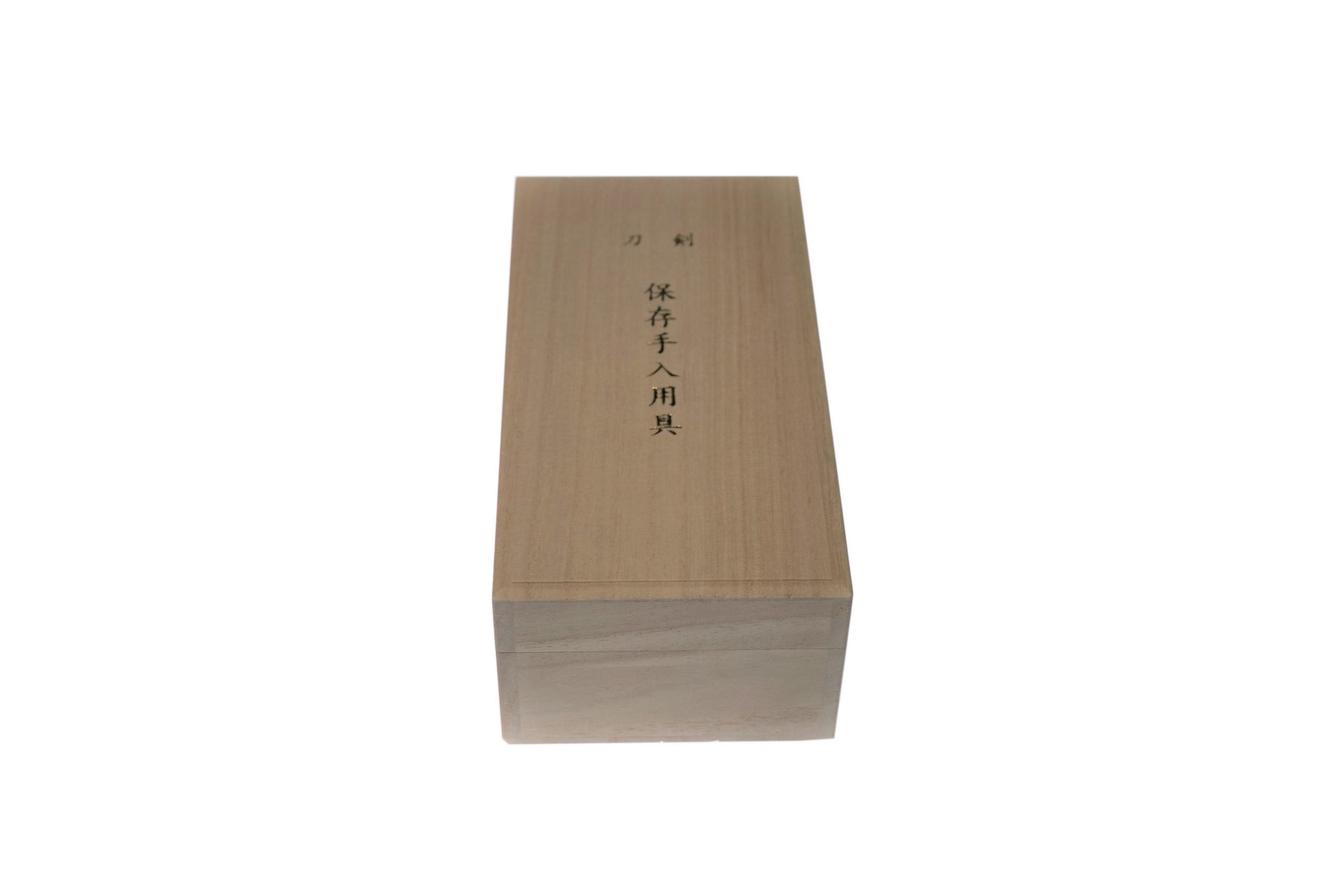
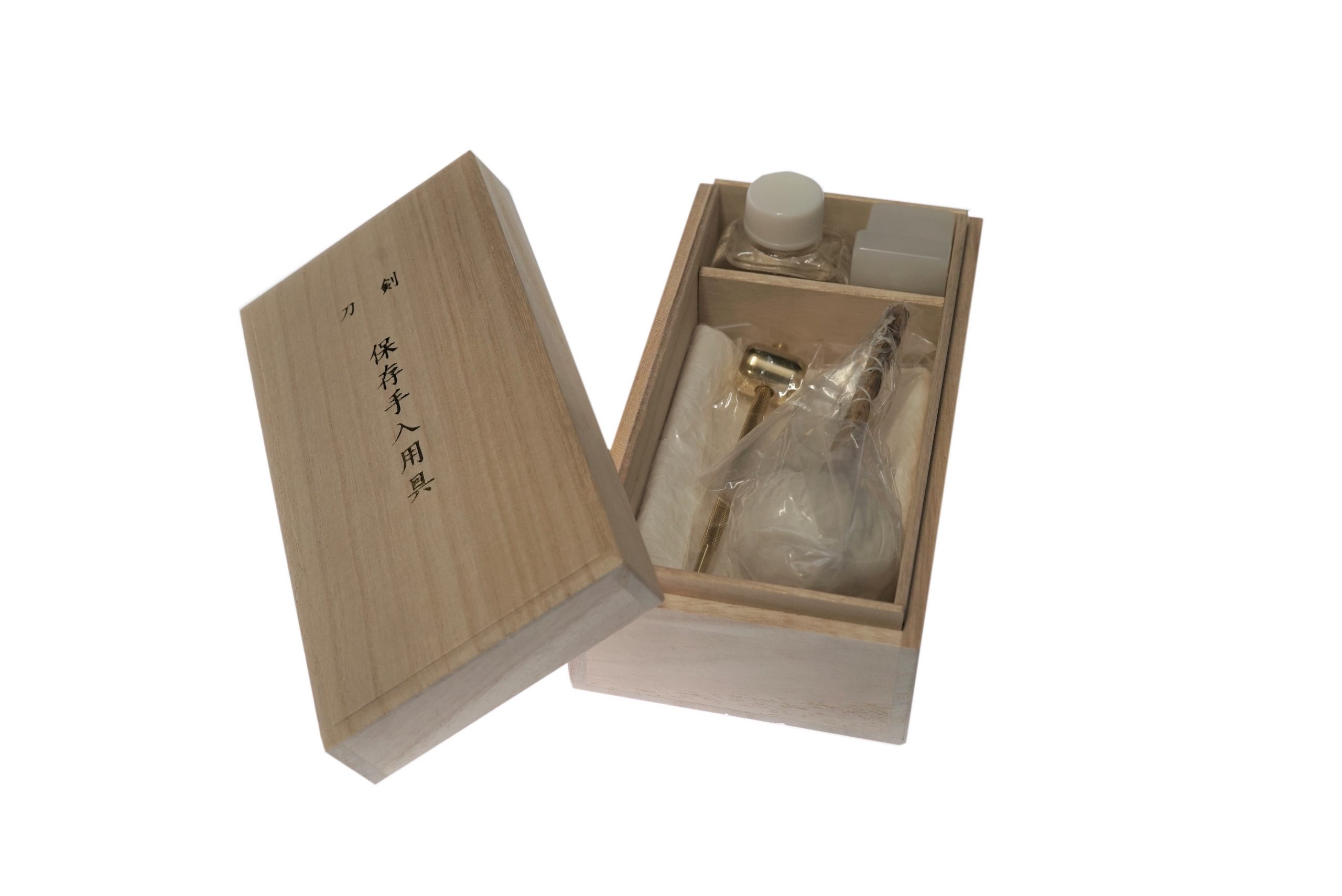
MORE ANTIQUE JAPANESE SWORD FOR SALE
SWORDS WITHOUT CERTIFICATES FOR SALE
LEARN JAPANESE SWORD TERMINOLOGY
Thank you for reading all the information on the page. If you have any difficulty choosing the right Japanese sword for you, we will be more than happy to help you find the one that speaks to you the most. Please feel free to contact us.

